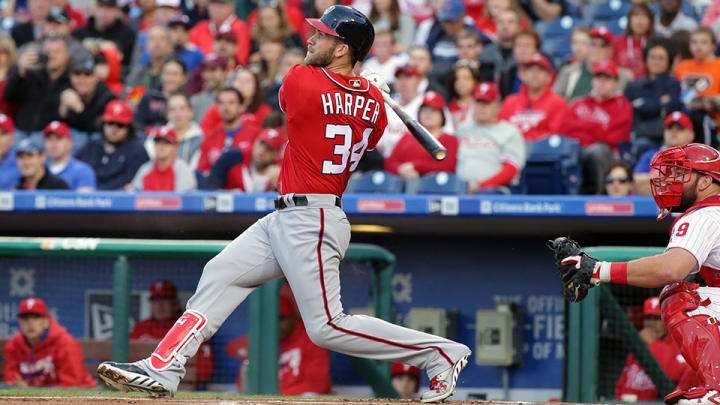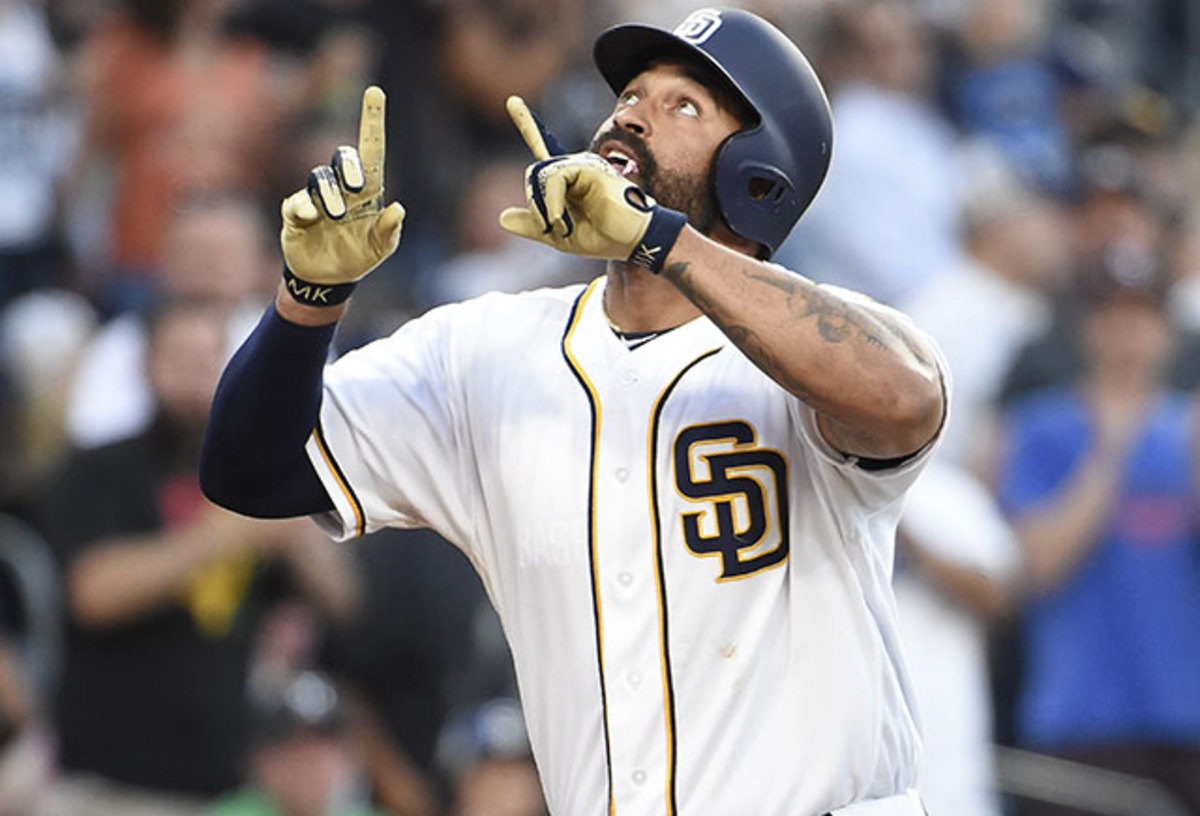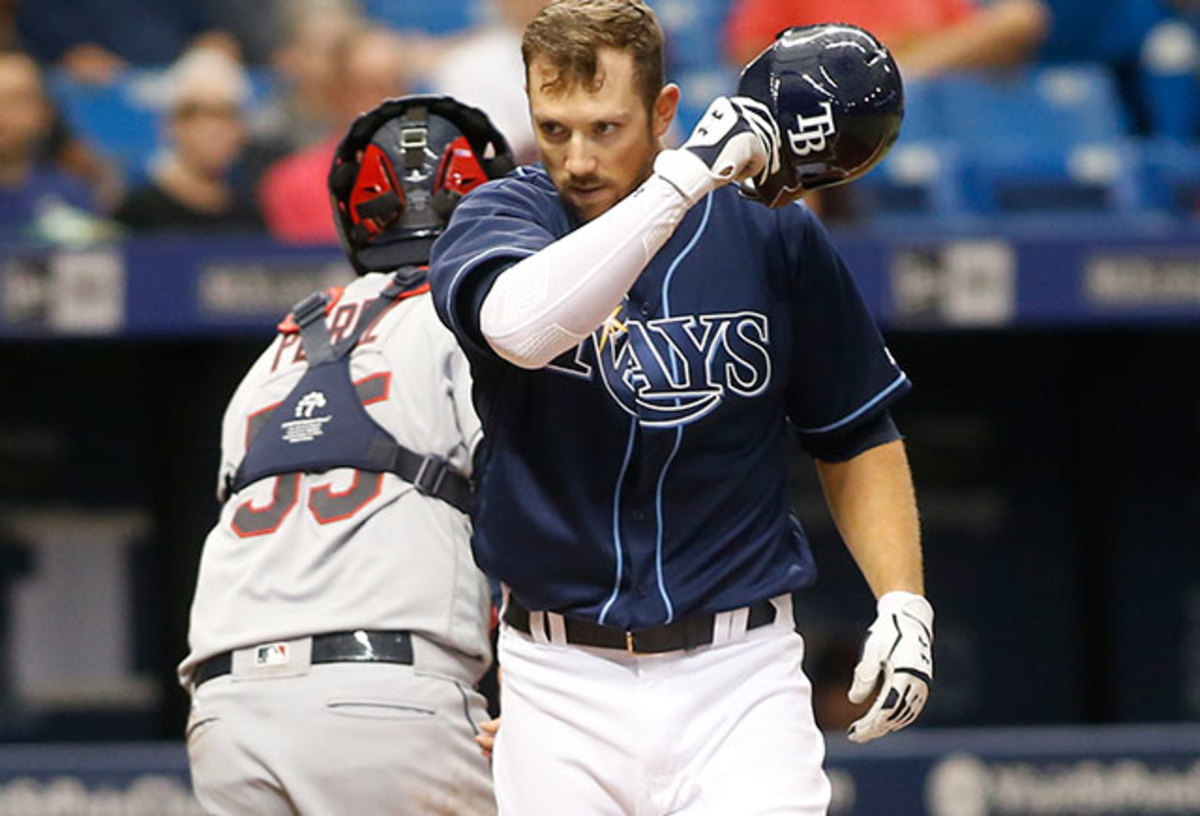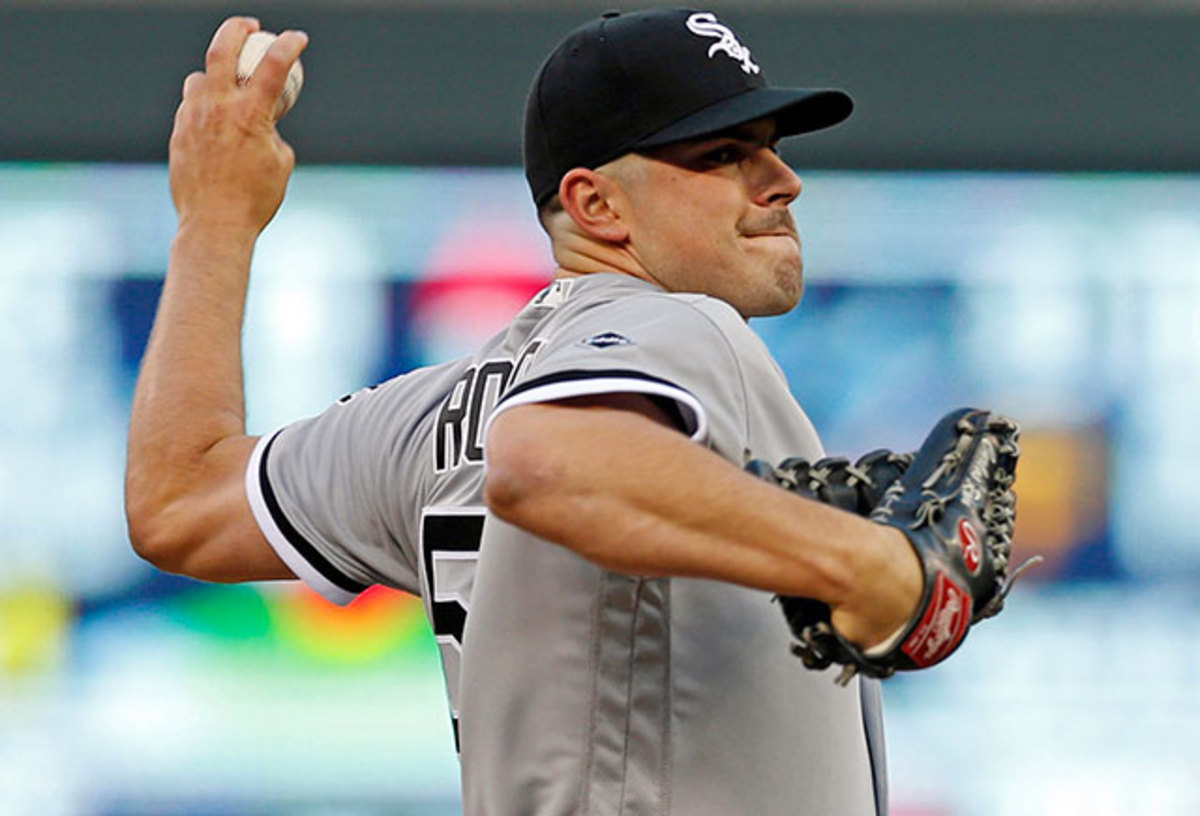The 30: Can Bryce Harper, Nationals keep up blistering pace?

With the last of the unbeaten teams now beaten (sorry, Orioles), the last of the winless finally off the schneid (woohoo, Braves and Twins!) and red-hot heroes now starting to look mortal (it wasn’t going to last forever, Trevor Story), we can now dig into players and teams without fairy tales of 140-win seasons and dreams of 80 home runs.
Still, the four teams profiled this week probably won’t keep up their current pace. The bigger question is: How far off their true talent records are these teams’ records? Are the Nationals truly the best team in the National League? Can the White Sox hang with the class of the American League? Will the Rays usher in their own version of the dead-ball era? Just how bad are the Padres, anyway?
The search for answers begins. It’s Week 2 of The 30.
Best News of the Week for People Who Enjoy Fun: The Adrian Beltre Extension
Beltre’s six-year, $96 million deal with the Rangers was set to expire at the end of this year, and no one would’ve blamed him for calling it a career at the end of his 19th major league season, nor the Rangers for letting him walk, given his age (37) and their many talented prospects waiting in the wings. Texas signed him anyway, giving Beltre a two-year, $36 million extension that keeps him locked up through 2018.
Future Hall of Famer Adrian Beltre is missing one thing: a ring
Now, Rangers fans have two reasons to rejoice. First, they’ll get to celebrate Beltre getting inducted into the Hall of Fame in the summer of 2024. He already ranks fifth all-time among third basemen in both Wins Above Replacement and JAWS, a stat developed by Jay Jaffe that measures both career and peak value. If he produces three more quality seasons (including the current one) before he retires, Beltre could end up third all-time in both categories, trailing only Mike Schmidt and Eddie Mathews. Though his offensive numbers might fall short of some other all-time great hot cornermen, Beltre’s defense—which won him four Gold Gloves and should have netted him a few more—elevates him into baseball immortal status. When Cooperstown comes calling, Beltre will go in as a Ranger, too, thanks to his spending more time in Arlington than anywhere else (eight seasons at the end of 2018) and notching all but one of his All-Star appearances in a Texas uniform.
But it’s the flair with which Beltre plays the game, and the glee he engenders among fans, that might be his best quality. There’s his unreal ability to launch home runs from one knee, his infectious laughter, his legendary dance moves, and of course, there's his violent opposition to anyone coming anywhere close to touching his head. For two more seasons, we’ll all get to rejoice, knowing our best baseball friend will be back.

KempWatch
Every homer the Padres' rightfielder hits moves A.J. Preller one step closer to unloading an albatross.
30. Atlanta Braves (3–9 record, minus-25 run differential, last week: 30)
29. Minnesota Twins (3–9, minus-18, LW: 28)
28. San Diego Padres (4–9, minus-17, LW: 27)
27. Miami Marlins (3–7, minus-4, LW: 26)
26. Philadelphia Phillies (6–7, minus-18, LW: 29)
25. Milwaukee Brewers (5–7, minus-29, LW: 24)
24. Cincinnati Reds (6–6, minus-14, LW: 22)
Melvin Upton Jr.’s walk-off homer Saturday night ended a 14-inning marathon and offered a jolt of life for a Padres team that’s delivered very few reasons for excitement since Opening Day 2015. But it was a home run cranked 11 innings earlier that could prove more beneficial in the long run.
Leading off the bottom of the third, Matt Kemp took Arizona starter Matt Buschmann 377 feet over the wall in left. That marked his fourth homer of the young season, leaving him behind only Trevor Story and Bryce Harper for the NL lead. Kemp also ranks in the top 10 in RBIs and owns a handsome .532 slugging average. Seeing the All-Star outfielder mash doesn’t mean much for the 2016 Padres, because they’re almost certainly going to be bad. What it might do, hopefully, is attract interest from potential buyers.
With the irrational exuberance of the Padres' 2014–15 offseason now well behind us, selling off older, high-priced talent becomes the obvious goal. Kemp is 31 years old, five seasons removed from what should have been an MVP season (had voters been able to understand that one player doesn’t much control over an entire team’s fortunes). He’s also owed $21.5 million a year from this season through 2019. Even if Kemp rakes for the next few months, it’s tough to imagine any team taking on that entire salary commitment and sending back quality prospects in return, due to his age, injury history and lesser performance at this stage of his career. Still, he did whack 48 combined homers in 2014 and '15, and Petco Park isn’t as tough on righthanded sluggers as it is on lefties, nor is it as punitive a park for hitters in general in the past couple seasons. There could be a market here, if the Padres are willing to absorb a bunch of money.
Go inside how one team is embracing the new market inefficiency
So which teams could be a good fit for a Kemp deal? You have to eliminate all NL teams right off the bat, given his lousy defense. We should also rule out teams on the lower end of the spending scale and/or in rebuilding/retooling mode. That means no Rays, Athletics, Twins and Indians, and realistically, the Astros and Royals probably aren’t happening either. The Yankees have at least three players in their starting nine who should be at designated hitter, so we should likely count them out. You have to figure the Red Sox learned their lesson with past-their-prime, defensively challenged players already. The Jays have enough of a dilemma regarding walk-year sluggers Jose Bautista and Edwin Encarnacion without thinking about an inferior, more expensive version of both. Mike Ilitch doesn’t give a crap about fiscal responsibility, but even he might stop short of a Kemp trade, following the Prince Fielder and Victor Martinez free-agent fiascos. Albert Pujols is under contract for another 47 million years, and his perennial leg problems will shove him to permanent DH duty soon enough. The Rangers took Fielder off Detroit’s hands. The Mariners already have Nelson Cruz and Seth Smith, neither of whom should be playing the outfield.
That leaves the White Sox and Orioles. The problem is that Kemp’s batting eye has gone to hell over the past two-plus seasons, and he’s sitting on a .286 on-base percentage, with one walk in 49 plate appearances. So yeah, a whole bunch more homers in the very near future would be most welcome.

Mendoza Territory
Just how bad is the Rays’ offense, really?
23. Arizona Diamondbacks (5–8, minus-14, LW: 21)
22. Los Angeles Angels (5–7, minus-14, LW: 25)
21. Oakland A’s (6–7, minus-6, LW: 19)
20. Colorado Rockies (7–5, minus-9, LW: 23)
19. Tampa Bay Rays (5–7, minus-8, LW: 20)
18. Seattle Mariners (5–7, plus-0, LW: 18)
17. Cleveland Indians (5–5, minus-1, LW: 17)
16. New York Yankees (5–6, minus-1, LW: 13)
The Rays finally scored their first series win of the season over the weekend, taking two out of three from a good White Sox squad. Even in victory, though, Tampa Bay didn’t exactly light up the scoreboard, tallying 11 runs over those three weekend games. Through the first 12 games of the season, the Rays have scored more than three runs just three times.
Compare Tampa's early offense to the rest of the AL, and things get even uglier. The Rays rank dead last in the Junior Circuit in both batting average and on-base percentage. Among AL teams, only the Twins have scored fewer runs. The offense-deadening properties of Tropicana Field aren’t widely known outside baseball’s deep analytical circles, but they shouldn’t be understated: The Trop consistently ranks as one of the most hostile parks for hitters in each of the past three seasons. Still, even after you adjust for park factors, the Rays have thus far shown off the kind of multi-faceted incompetence no team wants to see: They rank 10th in isolated slugging (slugging average minus batting average) and second-to-last in walks (Fangraphs’ Jeff Sullivan details the Rays’ uncommon aggressiveness at the plate here) among AL teams.
Here’s where we offer a dose of optimism to offset all that ugliness. First, the Rays figure to win a bunch of low-scoring games this year. Chalk up Sunday’s 3–2 win over the White Sox, for instance, to Matt Moore increasingly looking like the dynamic lefthander that he was before Tommy John surgery cost him huge chunks of the 2014 and '15 seasons. Moore went 6 1/3 innings against the Pale Hose, allowing two runs on five hits, striking out 10 and walking no one. His numbers so far this year: 18 1/3 innings, 15 hits, three walks, 21 strikeouts and a 2.95 ERA.
The pitching staff should only get deeper and better as we get further into the season, too. Closer Brad Boxberger is due back in mid-May. Talented righthander Alex Cobb could be back from Tommy John surgery in July. Most intriguing of all is Blake Snell, one of the best pitching prospects in baseball. The 23-year-old lefty has struck out 481 batters in 431 2/3 career minor league innings, and he’d almost certainly be taking the ball every fifth day for the Rays if not for baseball’s service-time rules, which reward clubs for keeping elite talents in the minors until mid-to-late June by potentially saving them millions of dollars in future arbitration awards.
Panda for sale: Could Red Sox get anything for Pablo Sandoval?
But while the Rays’ deep stable of starting pitchers and perennially strong defense makes it seem that this team can only compete through run prevention, we should expect better tidings from the offense, too. For one thing, the personnel is stronger than it was last year, thanks to the acquisition of Corey Dickerson over the winter. A perceived performance risk due to his iffy road numbers outside of Coors Field (he batted .257 with a .272 OBP on the road last year), Dickerson has fared well in tougher hitting environments this season; he’s still struggling to get on base, but he’s also slugging .528 with three homers, at times flashing monstrous power. Meanwhile, underachievers abound: Logan Morrison is 2 for 32, Brad Miller is 4 for 35, Kevin Kiermaier is 5 for 29, and Steve Pearce has one extra-base hit in seven games. That’s not going to last.
And those are just the most egregious examples too: The Rays’ microscopic .212 team batting average largely stems from a brutal .256 batting average on balls in play. That’s the fifth-lowest figure in all of baseball, more than 40 points below league average, and mostly a product of bad luck and small sample size. It's highly unlikely to remain this low much longer.
It’s quite possible that, even at their best, the Rays don’t have the horses to compete with the top teams in the AL East. But they’re likely going to be competitive, they may well be a better-than-.500 club, and more often than not, they’re going to be a pain to play.

Southpaw Squad
The trio of Chris Sale, Jose Quintana and Carlos Rodon is a frightening combination for 2016 opponents.
15. Houston Astros (5–8, minus-13, LW: 12)
14. Toronto Blue Jays (6–7, plus-3, LW: 9)
13. New York Mets (5–6, plus-0, LW: 7)
12. Texas Rangers (7–6, plus-4, LW: 16)
11. Detroit Tigers (7–4, plus-15, LW: 14)
10. Chicago White Sox (8–4, plus-7, LW: 15)
9. Baltimore Orioles (8–3, plus-15, LW: 10)
Attention Eric Hosmer, Mike Moustakas, Joe Mauer, Jason Kipnis and any other lefthanded hitters in the AL Central: You might want to check your calendars frequently this summer. Because if the White Sox are coming to your town, you could be in for a long night.
Through eight starts this season, the three starters atop the White Sox rotation—Chris Sale, Jose Quintana, and Carlos Rodon—have combined to deliver the following line: 53 2/3 innings, 43 hits, 12 walks, 53 strikeouts and a 2.18 ERA. Though all three are lefties, the contrast in styles makes them fascinating to watch ... assuming you don’t have to face them.
Sale is the unquestioned ace, for good reason. Since 2012, he ranks fourth in the majors in strikeout rate, fourth in strikeout-to-walk rate and 11th in ERA among all major league starters. His slight frame, killer fastball-slider combination and experience in the bullpen led to early-career speculation that he could stick as a very good closer. Instead, he’s become something far more valuable: a true ace, pitching deep into games and vying for Cy Young awards. Sale mixes mid-90s velocity with terrific command and wields a tough changeup that only makes him more baffling. His name seems to come up in made-up trade rumors roughly every 10 minutes, which is what happens when you have a pitcher who’s both really great and also unbelievably affordable. If Chicago’s finally built a team that can compete with the class of the AL, though, there’s roughly a 0% chance that Sale will be going anywhere.
An MLB rarity: Velasquez, Garcia post 97 game scores on same day
Quintana doesn’t possess the kind of dominating stuff that Sale has, he’s never put up Cy Young-worthy numbers and he’s never made an All-Star team. But as a No. 2 or No. 3 starter, he’s been solid. Like Sale, Quintana eats innings—a valuable and increasingly rare skill at a time when teams increasingly count anything more than five effective innings from non-ace starters as a bonus. And while he can’t match Sale’s velocity, he pounds the strike zone just as well: Since 2013, Quintana owns the 17th-lowest walk rate among all AL starters. His go-to pitch is his curveball, which held opponents below a .200 batting average in each of the past two seasons. The White Sox got a terrific bargain here too, with Quintana in year three of a five-year, $21 million deal that includes two highly affordable $10.5 million club options in 2019 and '20.
Rodon is the new kid on the block and one of the biggest X-factors in the South Siders’ efforts to return to the playoffs for the first time since 2008. The No. 3 pick in the 2014 draft, Rodon was expected to zoom through the White Sox' system. He delivered, making his big-league debut just 10 months after getting drafted. From the start, his raw stuff was incredible, his results sometimes spotty. In his rookie season, he posted the highest walk rate of any AL starter with as many innings pitched. He’s still struggling to limit walks, issuing five unintentional free passes in 13 innings this year. Still, the swing-and-miss is there, and it can be terrifying. If you’re a hitter facing Rodon with two strikes, start praying to Flying Spaghetti Monster immediately. The slider of death is coming, and it’s going to make you weep.
Make Baseball Fun Again
That’s what Bryce Harper is doing for the first-place Nats, launching tape-measure homers for a team that could soon have more help coming.
8. Boston Red Sox (6–5, plus-3, LW: 8)
7. Pittsburgh Pirates (7–6, plus-1, LW: 5)
6. San Francisco Giants (7–6, plus-9, LW: 3)
5. St. Louis Cardinals (7–5, plus-35, LW: 11)
4. Los Angeles Dodgers (8–5, plus-24, LW: 4)
3. Kansas City Royals (8–4, plus-8, LW: 2)
2. Washington Nationals (9–2, plus-27, LW: 6)
1. Chicago Cubs (9–3, plus-40, LW: 1)
By blasting his 100th major league home run six months past his 23rd birthday, Bryce Harper became the eighth-youngest player in the game’s history to reach that milestone ... and the best may be yet to come.
As SI.com’s Cliff Corcoran wrote recently, Harper might actually be improving—no mean feat after the Musial-esque numbers he put up last year. The Nats' slugger is batting an incredible .359/.458/.897, going from Stan The Man to peak Barry Bonds-level power. But the bigger stat to watch might be his strikeout rate: He’s struck out in a tiny 8.3% of his times at bat this year, a figure that’s less than half his career average. While sexier stats such as home run rate and slugging average can take half a season or more to become predictive of true performance, we can start to trust a hitter’s strikeout rate in as few as 150 plate appearances. If Harper can combine his prodigious power with a strikeout rate low enough to rank among the smallest in baseball, his overall numbers could become downright Nintendo-like. Harper’s ability to heavily influence baseball’s fashion and accessories trends only adds to his growing legend.
The bigger question for the Nationals is whether they can maintain anything close to this pace. On one hand, they’re in the midst of the easiest opening slate imaginable to start the season, playing the Braves, Marlins, Phillies and Twins to open the season; their first opponent with any kind of realistic playoff hope is St. Louis, and that series doesn’t start until we’re nearly into May. On the other hand, remember that Atlanta, Miami and Philadelphia all play in Washington’s division, so a bunch more matchups remain against those potential pushovers, a formula which helped push an already talented Mets club to greater heights to last year.
At 100 career homers, Bryce Harper shows signs of getting even better
Schedule aside, the Nationals’ talent level could get one of baseball’s biggest in-season jolts whenever Lucas Giolito makes his major league debut. A consensus top-10 prospect entering the season, Giolito has fanned 285 batters in 257 2/3 career minor league innings, allowing just 11 homers over that stretch. At 6'6", 255 pounds, he’s a physical specimen, capable of dialing his fastball into the mid-90s and also dropping a hammer curve that should immediately rank among the best in the league whenever he breaks in. If we’re going to keep going with the Mets comparison, Giolito has the stuff, command and repertoire to look a hell of a lot like Noah Syndergaard, the huge righthander who broke into New York’s rotation last May 12 and helped propel the team to its first World Series appearance in 15 years.
When it comes to Giolito’s arrival, the only question is when. The Nats currently have five healthy starters, meaning there’s no hole to fill. Tanner Roark would be the pitcher most likely to cede his starting job to Giolito, but he’s pretty damn good as fifth starters go, posting a 2.85 ERA over 31 starts two years ago and firing seven shutout innings in his last outing on Wednesday. Still, Nats principal owner Ted Lerner is 90 years old and has shown no hesitation in breaking the bank for premium talent such as Max Scherzer, and this is one of the last teams that would figure to get overcautious with a prospect just to save a few weeks of service time (and a few bucks in the process).
By park-adjusted, fielding independent pitching, the Nationals' bullpen ranked a merely decent 13th in the majors last year, and that was before they traded away top setup man Drew Storen. Moving Giolito to the rotation could improve the club’s starting five and also fortify the bullpen with Roark moving into a potentially valuable multi-inning reliever role. Stephen Strasburg and Wilson Ramos are free agents at year’s end, and even Harper, young as he is, has less than three years until he can test the open market, which given the potential windfall he stands to collect, seems likely to happen.
Given all that, you have to figure Washington won’t mess around much longer here. Over the past four seasons, the Nats have been one of baseball’s most talented clubs, yet they’ve fallen short year after year. When you’re a team in that spot, you’ve got a whiff-inducing, pie-baking, potential Thor clone on your hands, you should probably use him sooner rather than later.
